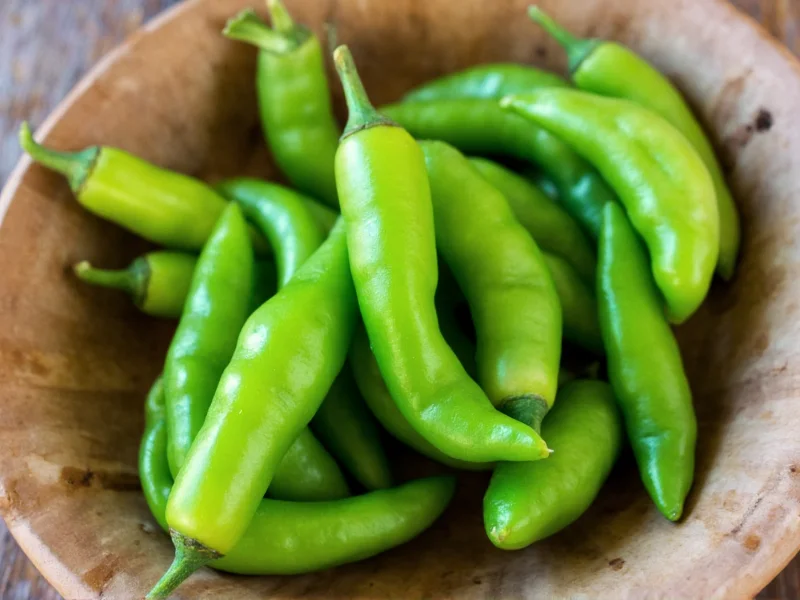When exploring are green chilli peppers hot, it's essential to understand that color alone doesn't determine a chili's heat. Many people mistakenly believe green chilies are always milder than red ones, but this common misconception needs clarification. The heat in chili peppers comes from capsaicin, a chemical compound concentrated in the white pith and seeds, not from the pepper's color stage.
The Science Behind Chili Heat
Capsaicin is the active component responsible for the burning sensation we perceive as “heat.” This compound interacts with pain receptors in our mouth and throat, triggering the familiar spicy response. The concentration of capsaicin determines a pepper's position on the Scoville scale, which measures pungency.
Contrary to popular belief, green chili peppers aren't inherently less hot than red ones. Many varieties are simply harvested while still green (unripe), but their potential heat remains the same as when they mature to red. For example, a green jalapeño has similar capsaicin levels to a red jalapeño—the main differences are flavor profile and sweetness, not necessarily heat intensity.
Green Chili Varieties and Their Heat Levels
Understanding why are green chili peppers hot requires examining specific varieties. The following table shows common green chilies and their Scoville Heat Units (SHU):
| Green Chili Variety | Scoville Heat Units (SHU) | Heat Description |
|---|---|---|
| Green Bell Pepper | 0 SHU | Not hot at all |
| Green Banana Pepper | 0-500 SHU | Mild to very mild |
| Green Jalapeño | 2,500-8,000 SHU | Moderately hot |
| Green Serrano | 10,000-23,000 SHU | Hot |
| Green Habanero | 100,000-350,000 SHU | Extremely hot |
Factors That Actually Determine Heat Level
When considering how hot are fresh green chilies, several factors influence spiciness beyond just color:
- Varietal genetics: Different pepper species have genetically predetermined capsaicin production levels
- Growing conditions: Stressors like water scarcity can increase capsaicin concentration
- Part of the pepper: The placenta (white pith) contains the highest capsaicin concentration
- Ripeness stage: Some varieties actually become hotter as they mature from green to red
- Individual plant variation: Even within the same variety, heat can vary significantly
Common Misconceptions About Green Chilies
One widespread myth suggests that difference between green and red chili heat is substantial, with green always being milder. While some varieties like poblanos do become slightly hotter as they ripen to red, others like habaneros maintain similar heat levels throughout ripening. The green-to-red transition primarily affects flavor (developing sweetness) and nutritional content (increased vitamins), not necessarily heat.
Another misconception involves the belief that removing seeds automatically makes green chilies mild. While seeds do contain capsaicin, the highest concentration resides in the white pith surrounding them. Simply removing seeds without addressing the pith yields minimal heat reduction.
Practical Implications for Cooking
When working with green chili peppers, consider these practical tips:
- Always taste a small piece before adding to dishes—heat levels vary even within the same batch
- Wear gloves when handling extremely hot varieties like green Scotch bonnets
- Balance heat with dairy products (milk, yogurt) or acidic ingredients (lime juice)
- Understand that cooking doesn't eliminate capsaicin—it redistributes throughout the dish
- Store fresh green chilies in the refrigerator for up to two weeks to maintain quality
Why Some Green Chilies Are Mild While Others Burn
The question are jalapeno peppers hot when green has a nuanced answer. Standard jalapeños range from 2,500-8,000 SHU, placing them firmly in the “hot” category, though not extremely so. However, some jalapeño varieties like “TAM Mild” have been specifically bred for lower heat. Similarly, while most serranos are hot even when green (10,000-23,000 SHU), certain growing conditions might produce milder specimens.
For those exploring capsaicin content in green chili peppers, remember that environmental stressors often increase heat production. A jalapeño grown in ideal conditions might test at 3,000 SHU, while the same variety stressed by drought could reach 8,000 SHU. This natural defense mechanism explains why heat levels can surprise even experienced cooks.
Are all green chili peppers hot?
No, not all green chili peppers are hot. While many green chilies like jalapeños and serranos are spicy, green bell peppers contain zero capsaicin and are completely mild. The heat depends on the specific variety, not the green color itself.
Why are some green chilies hotter than red ones?
Some green chilies can be hotter than their red counterparts because certain varieties increase capsaicin production as they mature. Environmental factors like water stress also affect heat levels more than color. The common belief that green always means milder is inaccurate.
Does cooking green chili peppers reduce their heat?
Cooking doesn't eliminate capsaicin, the compound responsible for heat in green chili peppers. While prolonged cooking can distribute heat more evenly throughout a dish, it doesn't significantly reduce the overall spiciness. The capsaicin remains stable through normal cooking temperatures.
How can I reduce the heat of green chili peppers?
To reduce heat in green chili peppers, remove the white pith and seeds where capsaicin concentrates. Soaking cut peppers in salt water or dairy products can also draw out some capsaicin. For significant heat reduction, consider using milder varieties like poblano instead of jalapeño or serrano.
Do green chili peppers get hotter as they ripen to red?
This varies by variety. Some peppers like poblanos become slightly hotter as they ripen to red, while others like jalapeños maintain similar heat levels throughout ripening. Certain varieties actually decrease in heat as they mature. The color change primarily affects flavor and nutritional content more than spiciness.











 浙公网安备
33010002000092号
浙公网安备
33010002000092号 浙B2-20120091-4
浙B2-20120091-4